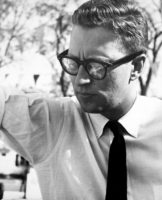Much of the excitement over the Metropolitan Opera’s production of Alban Berg’s Wozzeck has centered around South African artist William Kentridge’s idiosyncratic staging. The haunting set design features an intricate interaction of two dimensional and three-dimensional forms with a blurring of ephemeral animations and projected images in the background, and a static physical framework in front.
With assistance from set designer Sabine Theunissen and projection designer Catherine Meyburgh, Kentridge has created a sepulchral atmosphere in which there are no scene changes, no dropping of the stage curtain, and no moving of any machinery, but fragments do collapse for theatrical effect.
Kentridge’s famous charcoal drawings come to life throughout the opera, reinforcing the ominous theme. A high note though, is the super scale projection of the townspeople’s festive dancing before the apocalyptic ending.
Oh, and by the way, Met Music Director Yannick Nézet-Séguin was an equal match for Kentridge, drawing a richly-layered, dynamic performance from the Met’s orchestra that kept pace with the artist’s frenetic production. The strong cast, was led by, baritone Peter Mattei, who brought a heartbreaking sweetness to a role often infused with a harsh anger as the soldier sinks into despair and soprano Elza van den Heever, as his lover.












Post a comment to this article
Report Abusive Comment